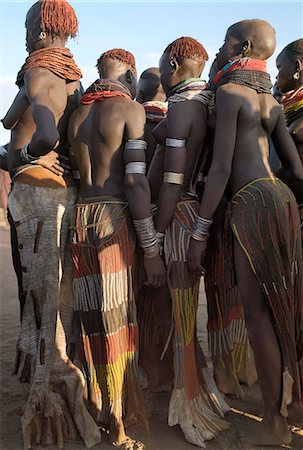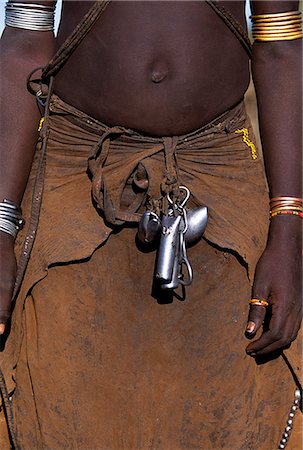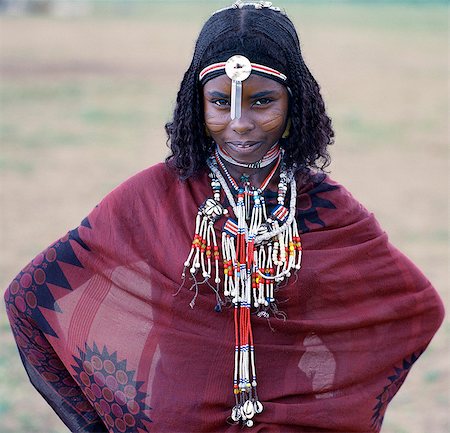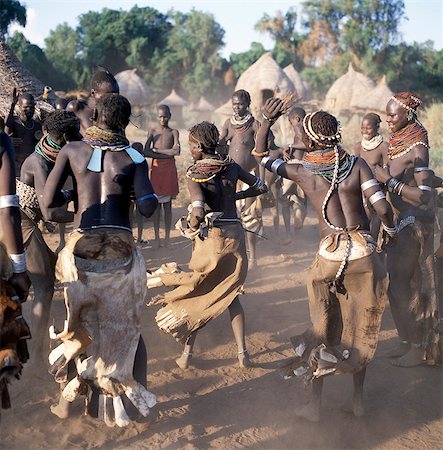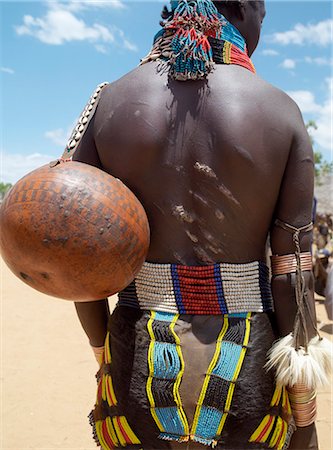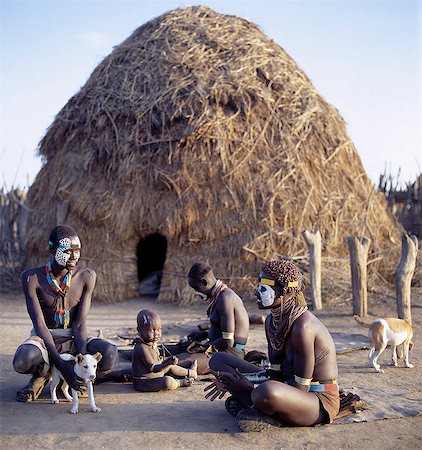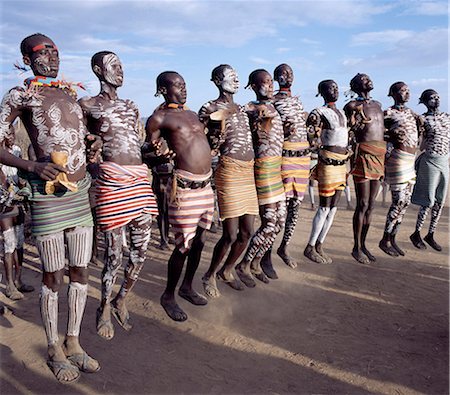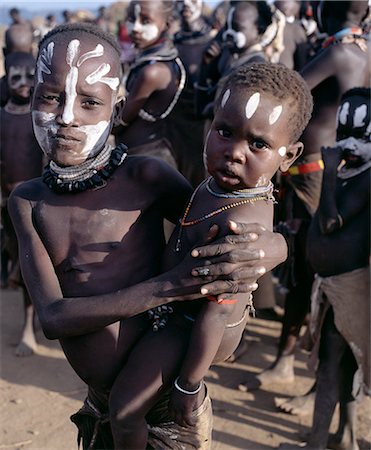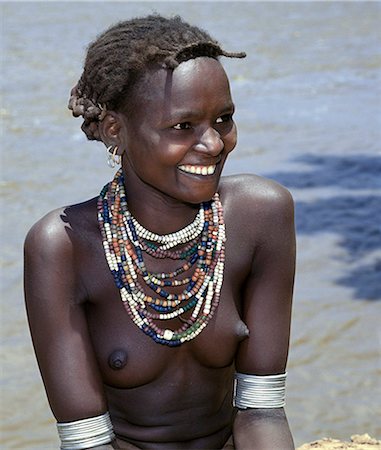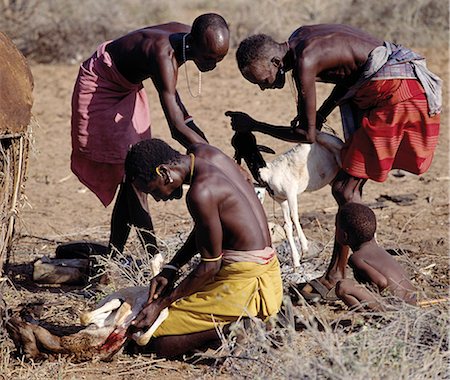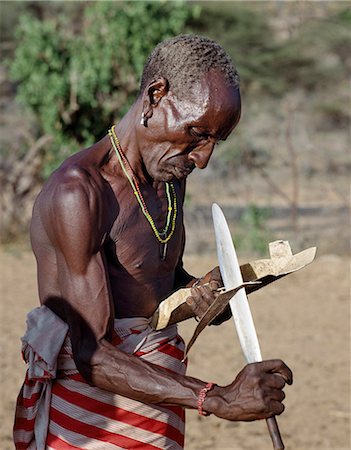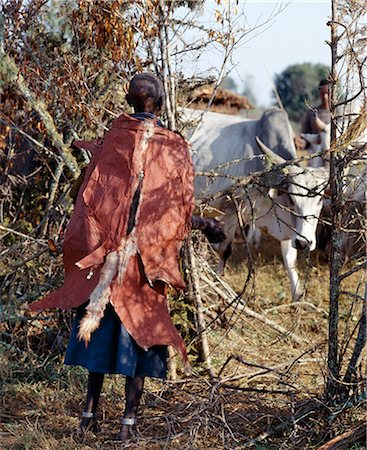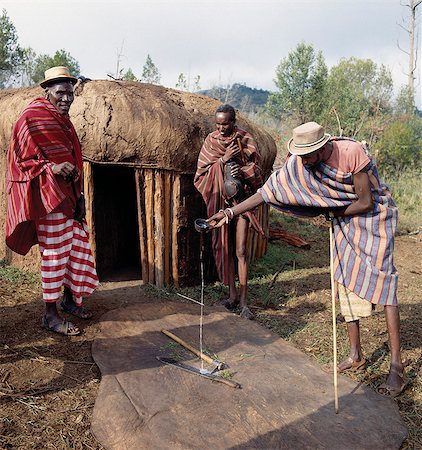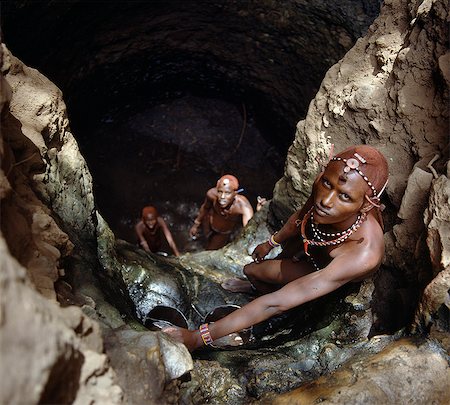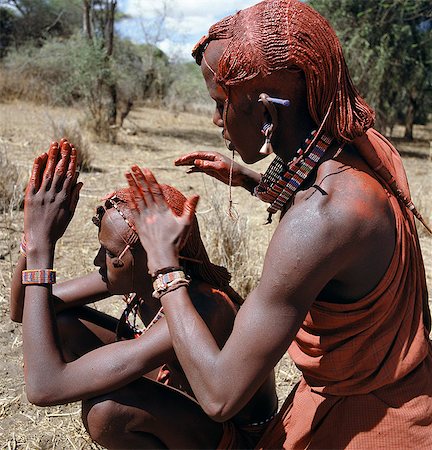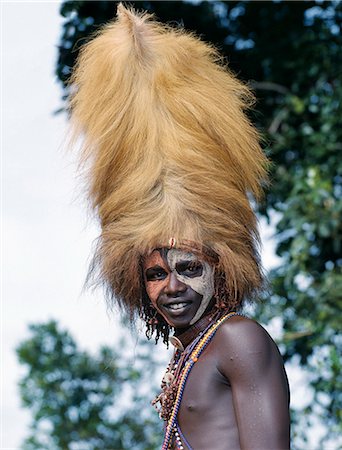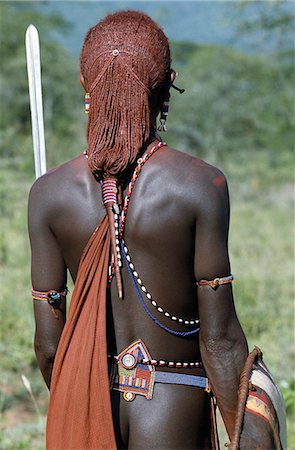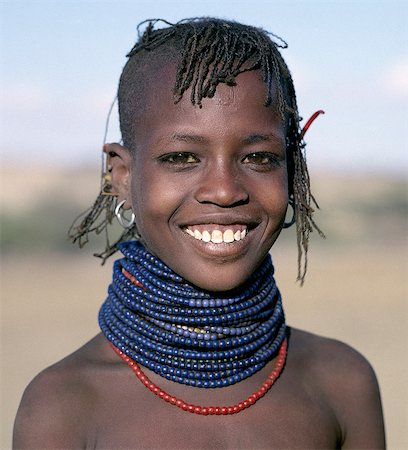-
A Tsemay girl of southwest Ethiopia wears a leather skirt and bright beaded jewellery. She belongs to a small tribe living close to the Konso people.
Con derechos protegidos
-
Two young Karo girls stand in front of the massive trunk of a fig tree. A small Omotic tribe related to the Hamar,who live along the banks of the Omo River in southwestern Ethiopia,the Karo are renowned for their elaborate body painting using white chalk,crushed rock and other natural pigments.
Con derechos protegidos
-
A Dassanech girl braids her sister's hair at her village in the Omo Delta. Much the largest of the tribes in the Omo Valley numbering around 50,000,the Dassanech (also known as the Galeb,Changila or Merille) and Nilotic pastoralists and agriculturalists.
Con derechos protegidos
-
A Nyangatom girl churns butter in a gourd suspended in the entrance to her hut. Typical of her tribe,she is wearing multiple layers of beads in necklaces,and an elaborately beaded calfskin skirt. The Nyangatom or Bume are a Nilotic tribe of semi-nomadic pastoralists who live along the banks of the Omo River in south-western Ethiopia.
Con derechos protegidos
-
A Datoga woman in traditional attire, which includes beautifully tanned and decorated leather dresses and coiled brass necklaces and ear ornaments.Extensive scarification of the face with raised circular patterns is not uncommon among women and girls.
Con derechos protegidos
-
A group of Nyangatom girls and women with beautifully decorated leather skirts gather to dance.The Nyangatom are one of the largest tribes and arguably the most warlike people living along the Omo River in Southwest Ethiopia.
Con derechos protegidos
-
A group of Nyangatom girls and women with beautifully decorated leather skirts gather to dance.The Nyangatom are one of the largest tribes and arguably the most warlike people living along the Omo River in Southwest Ethiopia.
Con derechos protegidos
-
A young Nyangatom woman carries her baby on her hip in an elaborately braided papoose. Her hair has been reddened with a mixture of ochre and animal fat. Typical of her tribe, she wears a calfskin skirt, multiple layers of bead necklaces and metal bracelets and amulets. The Nyangatom or Bume are a Nilotic tribe of semi nomadic pastoralists who live along the banks of the Omo River in south western
Con derechos protegidos
-
A Nyangatom woman wears multiple layers of beads in necklaces, an elaborately beaded calfskin skirt and metal bracelets, amulets and anklets. She is standing beside a temporary beehive construction of sticks, grass and leaves built to provide shade for her goats. The Nyangatom or Bume are a Nilotic tribe of semi-nomadic pastoralists who live along the banks of the Omo River in south western Ethio
Con derechos protegidos
-
A Nyangatom woman stands with her baby on her hip beside her grass hut in his temporary camp. Nyangatom married women wear elaborately beaded skirts which reach the ground at the back and often have panels of different coloured calkfskin sewn into the tail The Nyangatom or Bume are a Nilotic tribe of semi nomadic pastoralists who live along the banks of the Omo River in south western Ethiopia.
Con derechos protegidos
-
An Oromo old woman wears a necklace and a pendant made from a Maria Theresa thaler, an old silver coin minted in Austria, which was widely used as currency in northern Ethiopia and Arabia until the end of World War II. She was on her way to Senbete, an important weekly market close to the western scarp of the Abyssinian Rift.Afar nomads from the low lying arid regions of Eastern Ethiopia trek long
Con derechos protegidos
-
A Mursi woman wearing a large wooden lip plate. Shortly before marriage, a girls lower lip will be pierced and progressively stretched over a year or so. The size of the lip plate often determines the quantum of the bride price. They live in a remote area of southwest Ethiopia along the Omo River.
Con derechos protegidos
-
Shaded from the hot sun, a Karo woman grinds sorghum using large flat stones.It is customary for females of the tribe when in their teens to make a small hole in the flesh below their lower lips into which they put an ornament, this woman has used a small nail. Numerous heavy metal bracelets are worn by married womenThe Karo are a small tribe living in three main villages along the lower reaches o
Con derechos protegidos
-
A Hadza girl wearing a beaded headband and necklaces.The Hadzabe are a thousand-strong community of hunter-gatherers who have lived in the Lake Eyasi basin for centuries. They are one of only four or five societies in the world that still earn a living primarily from wild resources.
Con derechos protegidos
-
A young Dassanech girl holds her little brother. She wears a leather skirt with an elaborate fringe of wooden and metal tassles. Much the largest of the tribes in the Omo Valley numbering around 50,000,the Dassanech (also known as the Galeb,Changila or Merille) are Nilotic pastoralists and agriculturalists.
Con derechos protegidos
-
A young Dassanech girl holds her little brother. She wears a leather skirt with an elaborate fringe of wooden and metal tassles. Much the largest of the tribes in the Omo Valley numbering around 50,000,the Dassanech (also known as the Galeb,Changila or Merille) are Nilotic pastoralists and agriculturalists.
Con derechos protegidos
-
A young Dassanech girl wears a beautiful array of beaded necklaces,some secured at the back by metal rings,and a beaded headband. Her ears are pierced several times,the holes are kept open by small wooden plugs. Much the largest of the tribes in the Omo Valley numbering around 50,000,the Dassanech (also known as the Galeb,Changila or Merille) are Nilotic pastoralists and agriculturalists.
Con derechos protegidos
-
A young Dassanech girl wears a beautiful array of beaded necklaces. Much the largest of the tribes in the Omo Valley numbering around 50,000,the Dassanech (also known as the Galeb,Changila or Merille) are Nilotic pastoralists and agriculturalists.
Con derechos protegidos
-
A young Dassanech girl wears a leather skirt,metal bracelets and amulets and layers of bead necklaces. Much the largest of the tribes in the Omo Valley numbering around 50,000,the Dassanech (also known as the Galeb,Changila or Merille) are Nilotic pastoralists and agriculturalists.
Con derechos protegidos
-
A young Afar girl at Filwoha in the Awash National Park. Filwoha in the Afar language means 'hot water'. The beautiful springs are surrounded by doum palms and rise from deep underground at about 96.8 degrees F.
Con derechos protegidos
-
An Afar girl with braided hair has very noticeable scarification on her cheeks. Scarification is practiced in only a few sections of her tribe. Proud and fiercely independent,the nomadic Afar people live in the low-lying deserts of Eastern Ethiopia.
Con derechos protegidos
-
An Afar girl has her attractive hairstyle embellished with buttons and beads,which is typical of the young girls of her tribe. Proud and fiercely independent,the nomadic Afar people live in the low-lying deserts of Eastern Ethiopia.
Con derechos protegidos
-
A warrior of the Kisongo section of the Maasai with his long Ochred braids decorated with beaded ornaments. His broad armulet is typical of the Kisongo living in northern Tanzania where white is the preferred colour of their beadwork.
Con derechos protegidos
-
Maasai warriors take enormous trouble over their appearance especially their long hair,which is braided,Ochred and decorated with beaded ornaments. This singular hairstyle sets them apart from the rest of their community.
Con derechos protegidos
-
Detail of a Maasai warrior's ear ornaments and other beaded or metal adornments. The Maasai practice of piercing ears in adolescence and gradually elongating the lobes is gradually dying out. This warrior's body and his long braids have been smeared with red ochre mixed with animal fat.
Con derechos protegidos
-
Turkana girls return home from a Waterhole with water containers made of wood. Their cloaks are goatskin embellished with glass beads.
Con derechos protegidos
-
An elder of the Karo tribe,a small Omotic tribe related to the Hamar,who live along the banks of the Omo River in southwestern Ethiopia. The Karo are renowned for their elaborate body painting using white chalk,crushed rock and other natural pigments. This man also has a clay hairdo typical of tribal elders. Like most adult males he carries a rifle.
Con derechos protegidos
-
A Nyangatom girl weaves a grass basket. The Nyangatom or Bume are a Nilotic tribe of semi-nomadic pastoralists who live along the banks of the Omo River in south-western Ethiopia.
Con derechos protegidos
-
A Hamar woman at Turmi Market.The Hamar are semi-nomadic pastoralists of Southwest Ethiopia whose women wear striking traditional dress Skins are widely used for clothing and heavy metal necklaces,bracelets and anklets form part of their adornments. Cowries are also popular to embellish a woman's appearance.
Con derechos protegidos
-
A smart young Hamar youth at Turmi Market.The Hamar are semi-nomadic pastoralists who live in harsh country around the Hamar Mountains of Southwest Ethiopia. Their whole way of life is based on the needs of their livestock. Cattle are economically and culturally their most important asset.
Con derechos protegidos
-
Two Hamar girl in fashionable dress at Turmi market. The Hamar are semi-nomadic pastoralists of Southwest Ethiopia whose women and girls wear striking traditional dress. Skins are widely used for clothing and heavy metal necklaces,bracelets and anklets form part of their adornments. Cowries are also popular yet the sea is 500 miles from Hamar country.
Con derechos protegidos
-
A Hamar girl in traditional attire. Her leather skirt is made from the twisted strands of goatskin. Cowries are always popular to embellish a woman's or girl's appearance.The Hamar are semi-nomadic pastoralists who live in harsh country around the Hamar Mountains of Southwest Ethiopia.
Con derechos protegidos
-
A Datoga young man in traditional attire.His braids are embellished with beads and aluminium can openers.Many of his white plastic bracelets are beautifully decorated with abstract and geometrical designs; long ago these bracelets would have been made of ivory.
Con derechos protegidos
-
A Datoga woman relaxes outside her thatched house.The traditional attire of Datoga women includes beautifully tanned and decorated leather dresses and coiled brass armulets and necklaces. Extensive scarification of the face with raised circular patterns is not uncommon among women and girls.
Con derechos protegidos
-
A Datoga woman relaxes outside her thatched house.The traditional attire of Datoga women includes beautifully tanned and decorated leather dresses and coiled brass armulets and necklaces.The Datoga live in northern Tanzania and are primarily pastoralists.
Con derechos protegidos
-
A Samburu mother shaves her sons head outside her home the day before he is circumcised.Round her neck hangs his nchipi, the distinctive decoration of every boy who participates in the circumcision ritual. The strings of blue beads terminate in large bronze coloured wings of a torpedo shaped beetle, Sterocera hildebrandti.
Con derechos protegidos
-
A Samburu boy the day before his circumcision.He has daubed the right side of his face and body with white clay while drawing water from a source that never dries up. Each boy will carry for this purpose a new gourd shaped container made by his mother from hollowed out wood.
Con derechos protegidos
-
Mothers rub animal fat into their sons cloaks to make them supple. This task is performed shortly before the boys set out on an arduous journey to collect sticks, staves and gum to make bows, blunt arrows and clubs after their circumcision.
Con derechos protegidos
-
A lively Nyangatom dance is enjoyed by villagers in the late afternoon.The elevated houses in the background are both homes and granaries, which have been built to withstand flooding when the Omo River bursts its banks The Nyangatom are one of the largest tribes and arguably the most warlike people living along the Omo River in Southwest Ethiopia.
Con derechos protegidos
-
A pregnant Nyangatom woman in traditional attire outside her neatly thatched home.The Nyangatom are one of the largest tribes and arguably the most warlike people living along the Omo River in Southwest Ethiopia.
Con derechos protegidos
-
A beautifully decorated leather skirt of a Hamar woman.The Hamar are semi nomadic pastoralists of Southwest Ethiopia who live in harsh country around the Hamar Mountains of Southwest Ethiopia.Their whole way of life is based on the needs of their livestock.
Con derechos protegidos
-
A Karo woman with her face painted in preparation for a dance in the village of Duss. A small Omotic tribe related to the Hamar, who live along the banks of the Omo River in southwestern Ethiopia, the Karo are renowned for their elaborate body painting using white chalk, crushed rock and other natural pigments. She is wearing a goatskin apron and carries a leather belt decorated with cowrie shells
Con derechos protegidos
-
A Karo women stands in the doorway to her hut in the village of Duss. A small Omotic tribe related to the Hamar, who live along the banks of the Omo River in southwestern Ethiopia, the Karo are renowned for their elaborate body painting using white chalk, crushed rock and other natural pigments. In addition to painting her face she has decorated her body with whorls of goat hair tied by leather co
Con derechos protegidos
-
An attractive Oromo girl in the medieval walled city of Harar. Her beaded jewellery sets her apart from Harari residents.Once an independent city state dating back to the early 16th century, Harar was incorporated into the Ethiopian Empire in 1887.
Con derechos protegidos
-
A Mursi girl, accompanied by her dog, carries a large clay pot to collect water from the Omo River. Her earlobes are already pierced and extended, and decorated with round clay discs.She is dressed in skins, attractively decorated with thin stripes.The culture, social organisation, customs and values of the people have changed little.
Con derechos protegidos
-
Two Mursi men with singular hairstyles play a game of bau as a young boy watches them. Most men possess rifles to protect their families from hostile neighbours.Body art is an important aspect of Mursi culture.They live in a remote area of southwest Ethiopia along the Omo River.
Con derechos protegidos
-
A Karo mother and child. Heavy metal bracelets are common among older women.The Karo are a small tribe living in three main villages along the lower reaches of the Omo River in southwest Ethiopia.
Con derechos protegidos
-
In the late afternoon, family and friends sit outside a high dome roofed Karo home.The Karo excel in body art. Before a dance, they will decorate their faces and torsos elaborately using local white chalk, pulverised rock and other natural pigments. The polka dot or guinea fowl plumage effect is popular.
Con derechos protegidos
-
Karo men excel in body art. Before a dance, they will decorate their faces and torsos elaborately using local white chalk, pulverised rock and other natural pigments. While older men style their hair with clay, young men prefer to braid theirs.Every man carries a wooden stool, which doubles as a pillow at night.The Karo are a small tribe living in three main villages along the lower reaches of the
Con derechos protegidos
-
Karo men excel in body art. Before a dance, they will decorate their faces and torsos elaborately using local white chalk, pulverised rock and other natural pigments. While older men style their hair with clay, young men prefer to braid theirs.Every man carries a wooden stool, which doubles as a pillow at night.The Karo are a small tribe living in three main villages along the lower reaches of the
Con derechos protegidos
-
Karo men excel in body art. Before a dance, they will decorate their faces and torsos elaborately using local white chalk, pulverised rock and other natural pigments. While older men style their hair with clay, young men prefer to braid theirs.Every man carries a wooden stool, which doubles as a pillow at night.The Karo are a small tribe living in three main villages along the lower reaches of the
Con derechos protegidos
-
The Karo of the Lower Omo River excel in body art. They decorate their faces and torsos elaborately using local white chalk, pulverised rock and other natural pigments. Even young children daub their faces before a dance.The Karo are a small tribe living in three main villages along the lower reaches of the Omo River in southwest Ethiopia.
Con derechos protegidos
-
Karo men excel in body art. They decorate their faces and torsos elaborately using local white chalk, pulverised rock and other natural pigments.While young men prefer to braid their hair, older men style their hair with clay, which they colour and decorate with ostrich feathers.The Karo are a small tribe living in three main villages along the lower reaches of the Omo River in southwest Ethiopi
Con derechos protegidos
-
Karo men excel in body art. They decorate their faces and torsos elaborately using local white chalk, pulverised rock and other natural pigments. Their braided hairstyles are typical of young men from the tribe.The Karo are a small tribe living in three main villages along the lower reaches of the Omo River in southwest Ethiopia.
Con derechos protegidos
-
Karo men excel in body art. They decorate their faces and torsos elaborately using local white chalk, pulverised rock and other natural pigments. Their braided hairstyles are typical of young men from the tribe.The Karo are a small tribe living in three main villages along the lower reaches of the Omo River in southwest Ethiopia.
Con derechos protegidos
-
Karo men excel in body art. They decorate their faces and torsos elaborately using local white chalk, pulverised rock and other natural pigments. Their braided hairstyles are typical of young men from the tribe.The Karo are a small tribe living in three main villages along the lower reaches of the Omo River in southwest Ethiopia.
Con derechos protegidos
-
A Dassanech elder wearing a traditional clay hairdo, topped with ostrich feathers. His broad beaded necklace is unusual for its size but his five brass earrings are a common decoration of both men and women.The Dassanech people live in the Omo Delta of southwest Ethiopia, one of the largest inland deltas in the world.
Con derechos protegidos
-
An old Dassanech man wearing a traditional metal lip ornament and metal earrings. His broad ivory armbands and his ivory tobacco container hanging round his neck, are uncommon because elephants no longer frequent the Omo Delta.The Dassanech people live in the Omo Delta of southwest Ethiopia, one of the largest inland deltas in the world.
Con derechos protegidos
-
An old Dassanech woman prepares her fields beside the Omo River with a digging stick in readiness to plant sorghum. This crude form of agricultural implement is in common use in this remote part of Ethiopia.
Con derechos protegidos
-
A young Daasanech girl beside the Omo River. Her hairstyle, necklaces and metal armbands are typical of her tribe.The Dassanech people live in the Omo Delta of southwest Ethiopia, one of the largest inland deltas in the world.
Con derechos protegidos
-
An old Kikuyu lady picks coffee.Taken in the 1960's,this photograph depicts a traditional form of dress and ear ornaments among Kikuyu women,which has completely disappeared.
Con derechos protegidos
-
Kenya, Samburu District, South Horr, Samburu District, Kenya. The ritual helpers of two Samburu boys slaughter and skin rams the day before the boys are circumcised. The boys will sit on the skins while they are being circumcised.
Con derechos protegidos
-
Kenya, Samburu District, South Horr, Samburu District, Kenya. A ritual helper of a Samburu boy makes him new sandals the day before he is circumcised which he will wear for a month and then discard.
Con derechos protegidos
-
The evening before a Samburu boy is circumcised,he must lean over his mother under a special ochred goatskin cape as she milks a cow that has not given birth more than twice. This milk will be kept overnight in a traditional wooden gourd-like container and will be poured over the boy's head just before he is circumcised early the next morning.
Con derechos protegidos
-
A Samburu mother wears an ochred goatskin cape ready for milking a cow the evening before her son is circumcised. This distinctive cape is worn only at circumcision ceremonies. The milk must be drawn from a cow that has not given birth more than twice and will be poured over her son's head just before he is circumcised early the next morning.
Con derechos protegidos
-
The day before Samburu boys are circumcised in their lorora,(a purpose-built circumcision encampment),senior elders will bless the sharp instruments of every household,such as pangas and axes,by pouring a little milk over them as they intone a blessing. The instruments must be laid out on the oxhide upon which the boy of each household will be circumcised.
Con derechos protegidos
-
Dressed in his black goatskin cloak,a Samburu boy puts his bundle of sticks,staves and gum on the roof of his mother's house. He has collected these with other boys from a special type of Commiphora tree during an arduous journey on foot of up to 200 miles. After his circumcision,he will make them into bows,blunt arrows and clubs.
Con derechos protegidos
-
A Samburu woman sews a leather cloak for her younger brother. For several weeks before a boy is circumcised,he must wear a charcoal-blackened cloak,which is made from three goatskins.
Con derechos protegidos
-
Gabbra women dance at a gathering in the village of Kalacha. The Gabbra are a Cushitic tribe of nomadic pastoralists living with their herds of camels and goats around the fringe of the Chalbi Desert.
Con derechos protegidos
-
Gabbra women dance at a gathering in the village of Kalacha. The Gabbra are a Cushitic tribe of nomadic pastoralists living with their herds of camels and goats around the fringe of the Chalbi Desert.
Con derechos protegidos
-
Gabbra women sing and dance to celebrate a wedding. The traditional metal ornamentation on their heads is called malmal.
Con derechos protegidos
-
A close-up of a Pokot woman's earrings,hairstyle and beaded ornaments. Only married women wear brass earrings and glass-beaded collars. The band over her head supports the weight of her heavy earrings.
Con derechos protegidos
-
A young married woman of the Pokot tribe. Her married status is denoted by her large brass earrings and broad beaded collars and necklaces that are smeared with animal fat to glisten in the sun.
Con derechos protegidos
-
Maasai warriors draw water from a deep well. The depth of wells is measured by the number of men required to bring water to the cattle troughs at the top of them. A three-man well will be about 24 feet deep since the buckets are thrown between the men in a rhythmic chant.
Con derechos protegidos
-
A Maasai warrior resplendent with long ochred braids tied in a pigtail at the back,puts red ochre on his friend's plaits. Red ochre is anatural earth,which is mixed with animal fat to the consistency of greasepaint.
Con derechos protegidos
-
Kenya,Trans-Mara,Lolgorien. The Maasai do not eat game meat or birds. Consequently,the wildlife in their vast grazing areas has been left relatively undisturbed. The warriors do hunt lions,however,when their cattle are killed. The warrior who spears a lion to death will make a busby-style headdress from its mane.
Con derechos protegidos
-
A back view of a Maasai warrior resplendent with long ochred braids tied in a pigtail. This singular hairstyle sets him apart from other members of his society. His beaded belt is of a style only worn by warriors. The little copper bell-shaped ear ornament hanging from his elongated and decorated earlobe is also peculiar to the Maasai.
Con derechos protegidos
-
A Maasai warrior with his long braids and body coated with red ochre mixed with animal fat. He has put ochre dust round his eyes to enhance his appearance ready for a dance. The singular hairstyles of Maasai warriors sets them apart from other members of their society.
Con derechos protegidos
-
A Maasai warrior has daubed himself with red ochre mixed with animal fat to participate in a dance. His long ochred braids have been drawn forward from the crown of the head and tied in three places. This singular hairstyle sets warriors apart from the rest of their society.
Con derechos protegidos
-
A Maasai warrior resplendent with long ochred braids. His body has been smeared with red ochre mixed with animal fat while parts of his face have been covered with ochre powder.
Con derechos protegidos
-
Kenya,Kajiado,Maparasha. A Maasai warrior resplendent with long,ochred braids. This singular form of hairstyle distinguishes warriors from the rest of their society. This man has looped his elongated and decorated earlobes over his ears - a common practice when walking through thorn scrub country to prevent the loops being snagged by thorns.
Con derechos protegidos
-
A Maasai warrior in full regalia. He has stuck a porcupine quill in his beaded headband to add to his other decorations. His long,Ochred plaits have been drawn forward from the crown of his head and tied in three bunches.
Con derechos protegidos
-
A Turkana girl in all her finery. Among the Turkana,cicatrization is a common form of beautification. She wears a crucifix given to her by a missionary; they are popular ornaments despite not necessarily being associated with Christianity.
Con derechos protegidos
-
Two Turkana girls set off to fetch water from a nearby Waterhole. Their water containers are made of wood by the women of the tribe. Their 'V' shaped aprons are made of goatskin and have been edged with hundreds and hundreds of round discs fashioned out of ostrich eggshells.
Con derechos protegidos
-
A jovial group of Turkana girls in traditional attire. Their aprons are made of goatskin,either beaded or cut into thin strips before braiding. The two girls in the middle have already had the flesh below their lower lips pierced in readiness for a brass ornament after marriage.
Con derechos protegidos
-
A pretty young Turkana girl has already had the flesh below her lower lip pierced in readiness for a brass ornament after her marriage. The rims of her ears have also been pierced and the holes kept open with small wooden sticks.
Con derechos protegidos
-
A young Turkana girl adorned with necklaces of a style the Southern Turkana prefer to wear.
Con derechos protegidos
-
A young Turkana girl has had the rims of her ears pierced in seven places and keeps the holes open with small wooden sticks. After marriage,she will hang leaf-shaped metal pendants from each hole.
Con derechos protegidos
-
A Turkana girl's necklaces are well-oiled with animal fat and glisten in the sun. Occasionally,a girl will put on so many necklaces that her vertebrae stretch and her neck muscles gradually weaken. The partially shaven head is typical of Turkana women and girls.
Con derechos protegidos
-
A Turkana girl's necklaces are well-oiled with animal fat and glisten in the sun. The use of red ochre has been copied from their Samburu neighbours and is not widespread. Occasionally,a girl will put on so many necklaces that her vertebrae stretch and her neck muscles gradually weaken. The partially shaven head is typical of Turkana women and girls.
Con derechos protegidos






